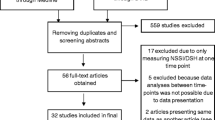Abstract
More than 20 % of adolescents may self-injure. Often there is no suicidal intent; rather the intent is to reduce distressing affect, inflict self-punishment and/or signal personal distress to important others. Non-suicidal self-injury (NSSI) is both deliberate and contains no desire to die and therefore aetiology is likely to be at least partly different to suicidal behaviour per se. Interestingly, NSSI is associated with subsequent suicide attempts suggesting that these behaviours and their related psychology may lie on the same risk trajectory. NSSI does not, however, appear in DSM-IV or ICD-10 as a disorder; and does not constitute a component of any current anxious or depressive syndrome. This lack of nosological recognition coupled with clear psychopathological importance is to be recognised in the 5th edition of the Diagnostic and Statistical Manual of Mental Disorders, with NSSI being classified as a syndrome in its own right. We agree that this is appropriate and is likely to have several positive consequences including improving communication between professionals and patients, informing treatment and management decisions and increasing research into the nature, course and outcome of NSSI. We agree that while suicidal and non-suicidal self-harm are often seen together, they are not the same behaviour and that it is both valid and useful to separate them.
Similar content being viewed by others
Abbreviations
- NSSI:
-
Non-suicidal self-injury
- DSM-5:
-
5th edition of the Diagnostic and Statistical Manual of Mental Disorders
References
Hawton K, James A (2005) Suicide and deliberate self harm in young people. BMJ 330(7496):891–894
Giletta M et al (2012) Adolescent non-suicidal self-injury: a cross-national study of community samples from Italy, the Netherlands and the United States. Psychiatry Res 197:66–72
Briere J, Gil E (1998) Self-mutilation in clinical and general population samples: prevalence, correlates, and functions. Am J Orthopsychiatry 68(4):609–620
APA (2010) Non-Suicidal Self Injury. In: APA DSM-5 Development. http://www.dsm5.org/ProposedRevisions/Pages/proposedrevision.aspx?rid=443#. Accessed 25 May 2012
APA, American Psychiatric Association (2000) Diagnostic and statistical manual of mental disorders: text revision, 4th edn. American Psychiatric Association, Washington, DC
WHO (1992) The ICD-10 classification of mental and behavioural disorders: clinical descriptions and diagnostic guidelines. World Health Organization, Geneva
Nock MK et al (2006) Non-suicidal self-injury among adolescents: diagnostic correlates and relation to suicide attempts. Psychiatry Res 144(1):65–72
Jacobson CM et al (2008) Psychiatric impairment among adolescents engaging in different types of deliberate self-harm. J Clin Child Adolesc Psychol 37(2):363–375
Brunner R et al (2007) Prevalence and psychological correlates of occasional and repetitive deliberate self-harm in adolescents. Arch Pediatr Adolesc Med 161(7):641–649
Zlotnick C et al (1997) Affect regulation and suicide attempts in adolescent inpatients. J Am Acad Child Adolesc Psychiatry 36(6):793–798
Wilkinson P et al (2011) Clinical and psychosocial predictors of suicide attempts and nonsuicidal self-injury in the adolescent depression antidepressants and psychotherapy trial (ADAPT). Am J Psychiatry 168(5):495–501
Asarnow J et al (2011) Suicide attempts and nonsuicidal self-injury in the treatment of resistant depression in adolescents (TORDIA) study. J Am Acad Child Adolesc Psychiatry 50(8):772–781
Cooper J et al (2005) Suicide after deliberate self-harm: a 4-year cohort study. Am J Psychiatry 162(2):297–303
Bridge JA, Goldstein TR, Brent DA (2006) Adolescent suicide and suicidal behavior. J Child Psychol Psychiatry 47(3–4):372–394
NICE (2011) Self-harm: longer-term management. National Collaborating Centre for Mental Health, London
Montgomery S et al. (1979) Maintenance therapy in repeat suicidal behaviour: a placebo controlled trial. In: Proceedings of the 10th International Congress for Suicide Prevention and Crisis Intervention. Ottawa, Canada
Bateman A, Fonagy P (2008) 8-year follow-up of patients treated for borderline personality disorder: mentalization-based treatment versus treatment as usual. Am J Psychiatry 165(5):631–638
Lynch TR et al (2007) Dialectical behavior therapy for borderline personality disorder. Annu Rev Clin Psychol 3:181–205
Katz LY et al (2004) Feasibility of dialectical behavior therapy for suicidal adolescent inpatients. J Am Acad Child Adolesc Psychiatry 43(3):276–282
Rossouw TI, Fonaghy P (2012) Mentalization-based treatment for self-harm in adolescents: a randomised control trial. JAACAP. doi:10.1016/j.jaac.2012.09.018
Hazell PL et al (2009) Group therapy for repeated deliberate self-harm in adolescents: failure of replication of a randomized trial. J Am Acad Child Adolesc Psychiatry 48(6):662–670
March J et al (2004) Fluoxetine, cognitive-behavioral therapy, and their combination for adolescents with depression: treatment for Adolescents With Depression Study (TADS) randomized controlled trial. J Am Med Assoc 292(7):807–820
Brent DA et al (2009) Predictors of spontaneous and systematically assessed suicidal adverse events in the treatment of SSRI-resistant depression in adolescents (TORDIA) study. Am J Psychiatry 166(4):418–426
Carrion VG et al (2008) Posttraumatic stress symptoms and brain function during a response-inhibition task: an fMRI study in youth. Depress Anxiety 25:514–526
Janis IB, Nock MK (2009) Are self-injurers impulsive?:results from two behavioral laboratory studies. Psychiatry Res 169(3):261–267
Jollant F et al (2010) Decreased activation of lateral orbitofrontal cortex during risky choices under uncertainty is associated with disadvantageous decision-making and suicidal behavior. Neuroimage 51:1275–1281
Raust A et al (2007) Prefrontal cortex dysfunction in patients with suicidal behavior. Psychol Med 37:411–419
Angold A, Costello EJ, Erkanli A (1999) Comorbidity. J Child Psychol Psychiatry 40(1):57–87
Conflict of interest
The corresponding author states that there are no conflicts of interest. This article is part of the supplement “The Future of Child and Adolescent Psychiatry and Psychology: The Impact of DSM 5 and of Guidelines for Assessment and Treatment”. This supplement was not sponsored by outside commercial interests.
Author information
Authors and Affiliations
Corresponding author
Rights and permissions
About this article
Cite this article
Wilkinson, P. Non-suicidal self-injury. Eur Child Adolesc Psychiatry 22 (Suppl 1), 75–79 (2013). https://doi.org/10.1007/s00787-012-0365-7
Published:
Issue Date:
DOI: https://doi.org/10.1007/s00787-012-0365-7




